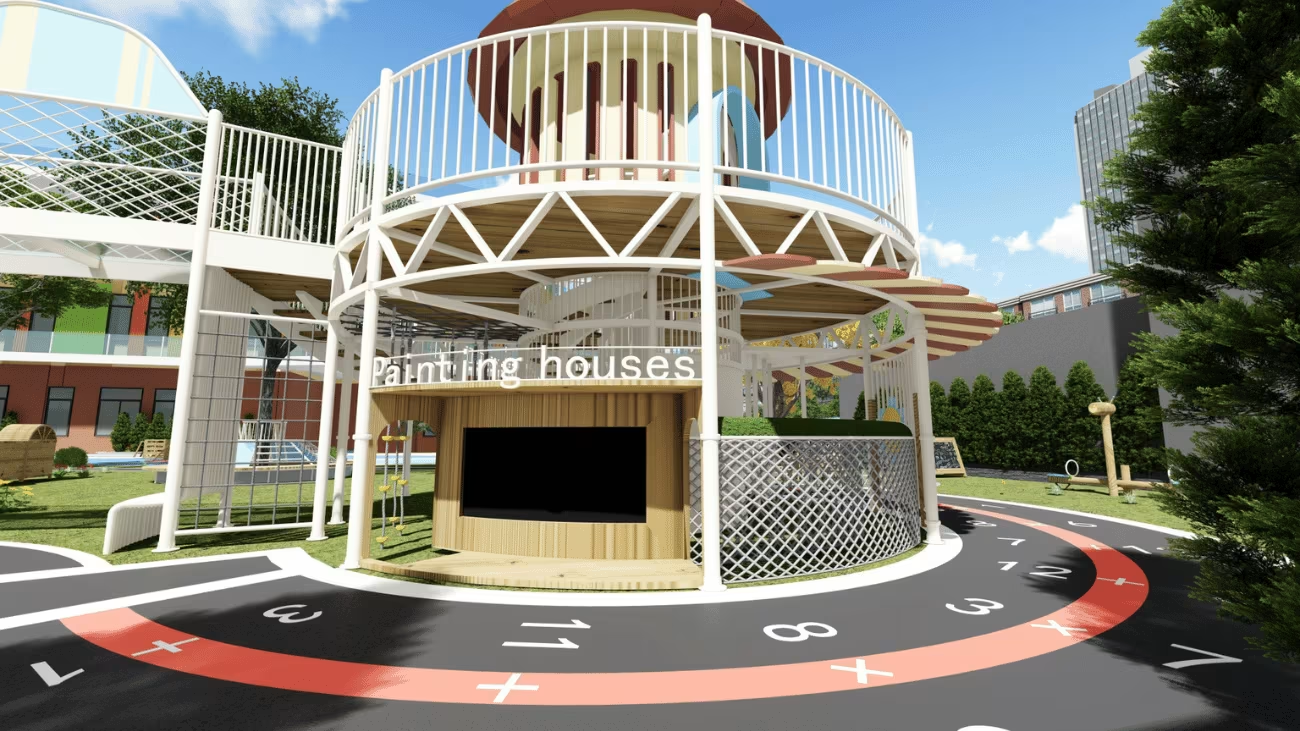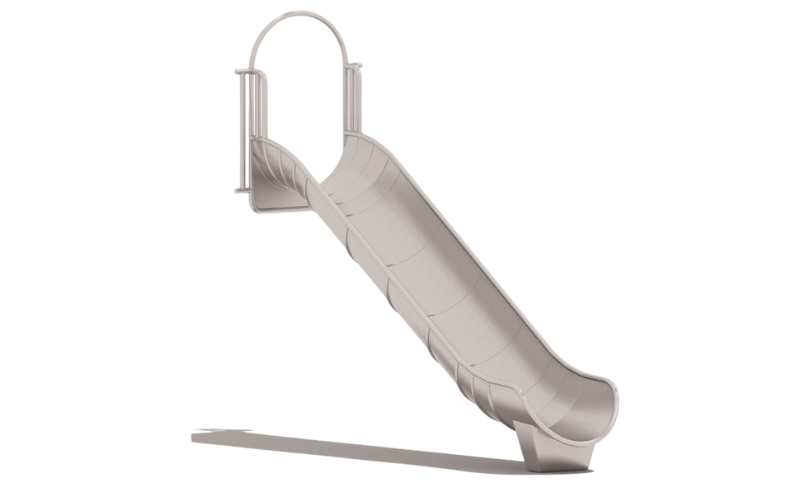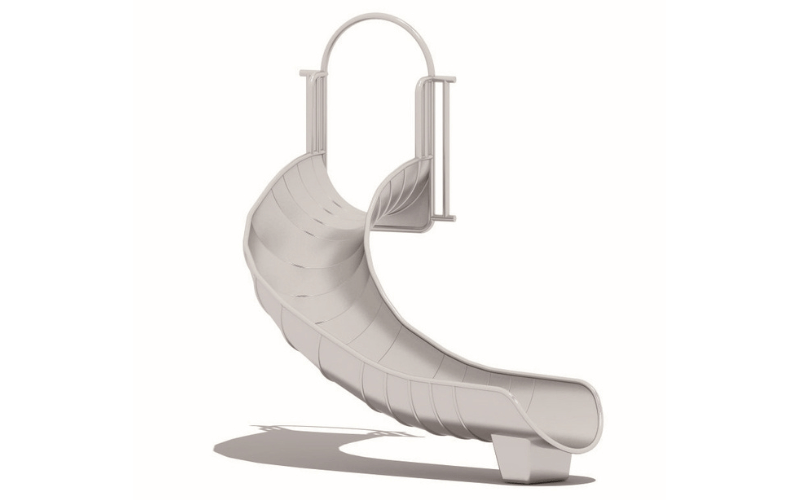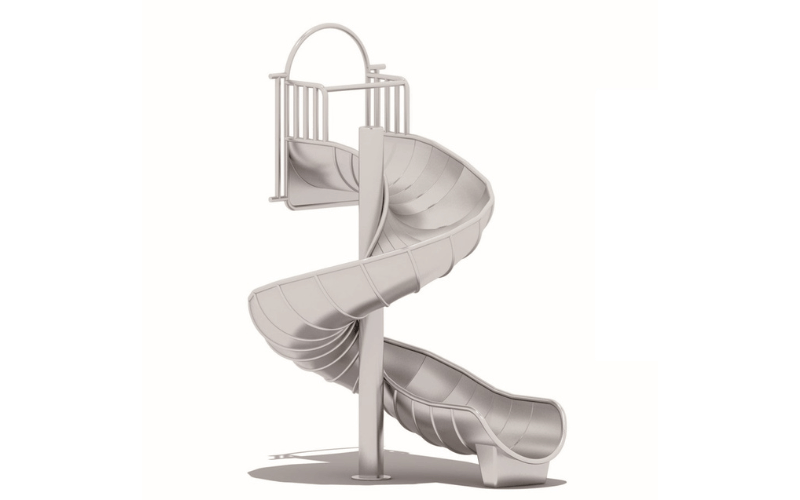If you’ve watched children at play in a park or schoolyard, you’ve witnessed the magic of well-designed playground equipment in action. While kids see exciting structures to climb, slide, and swing on, educators and urban planners recognize playgrounds as carefully engineered environments that promote physical, cognitive, and social development.
Most parents are unaware of the science behind playground design—how each piece of equipment serves specific developmental purposes while meeting rigorous safety standards. From classic swings to innovative climbing structures, modern playgrounds offer a diverse range of equipment types that cater to different age groups, abilities, and play styles.
Let’s explore the main categories of playground equipment, their unique benefits, and how they contribute to creating engaging, developmental play spaces.
Table of Contents
ToggleDefinition and Purpose
Playground equipment refers to the structures, tools, and features designed to provide recreational and developmental activities for children in outdoor or indoor play spaces. Common examples include slides, swings, climbing walls, monkey bars, and seesaws. These pieces are strategically built to promote active play while ensuring safety and durability.
The primary purpose of playground equipment is to create an environment that encourages children to engage in physical activity, foster creativity, and explore social interactions. Whether placed in parks, schools, or community centers, such equipment is designed to entertain and challenge children within a secure framework. Modern playgrounds often incorporate diverse materials like wood, metal, and plastic while meeting rigorous safety standards to accommodate various age groups and abilities.
Additionally, equipment may cater to multiple forms of play, such as imaginative, collaborative, or sensory-focused activities. These varied offerings ensure that children can explore their physical and mental capabilities in unique and exciting ways.
Why It’s Essential for Child Development
Playground equipment plays a vital role in supporting the holistic development of children. Physically, activities such as climbing, swinging, or balancing enhance motor skills, coordination, and overall fitness. Active play helps strengthen muscles, enhance endurance, and foster a healthy lifestyle from a young age.
On a cognitive level, playground equipment encourages problem-solving and decision-making skills. For instance, climbing a challenging structure requires planning and critical thinking, while navigating group dynamics during play sharpens communication and cooperation abilities.
Socially, playgrounds provide an essential space for children to interact with their peers outside of structured settings, such as classrooms. These shared play experiences help develop social skills, empathy, and teamwork while building lifelong friendships.
Emotionally, play on equipment can foster confidence and resilience as children conquer new challenges or try out unfamiliar activities. This environment enables them to test boundaries in a controlled and supportive setting.
Modern designs also emphasize inclusivity by incorporating features for children with diverse needs, ensuring every child has access to the same opportunities for growth and enjoyment. By offering both fun and functionality, playground equipment serves as a powerful tool to nurture well-rounded, healthy development in children.
Types of Playground Equipment
Traditional Equipment: Swings, Slides, and See-Saws
Traditional playground equipment forms the backbone of recreational spaces and has remained timeless due to its simplicity and universal appeal. Swings, in particular, are a staple in almost every playground, offering children a sensory experience while promoting balance and core strength. They also encourage social interaction, as children often take turns or swing side by side.
Slides are another classic, loved for the thrill they provide as children climb up and zip down repeatedly. Designs range from simple straight slides to spiral configurations, catering to a variety of age groups and activity levels. Modern slides often emphasize safety, using smooth materials and enclosed structures for added protection.
See-saws, with their up-and-down motion, introduce teamwork and coordination as children work together to enjoy the ride. This traditional piece of equipment is often found in multiple-seat variations, allowing more children to participate simultaneously.
Climbing Structures: Monkey Bars and Rope Climbs
Climbing structures are vital for building physical strength and motor skills, making them a favorite among active children. Monkey bars, a classic example, challenge kids to use their arm strength and coordination as they swing across the bars. They also provide a sense of accomplishment when successfully navigated, boosting confidence and resilience.
Rope climbs are another popular climbing option, often incorporated into larger obstacle structures. They encourage problem-solving as children figure out how to maneuver upward while building agility and endurance. With newer designs introducing nets and even combination courses, climbing structures have evolved to provide versatile challenges suited for different skill levels.

These components effectively combine fun and fitness, fostering a sense of adventure while developing essential physical skills.
Interactive Play: Sensory Panels and Musical Features
Interactive playground equipment goes beyond physical activity, engaging children’s sensory and cognitive abilities. Sensory panels, for instance, offer experiences like pressing buttons, twisting knobs, or exploring textured surfaces, which are particularly valuable for younger children or those with sensory needs. These features can captivate attention while promoting fine motor skills and curiosity.
Musical play elements such as outdoor xylophones, drums, or chimes add a creative dimension to playgrounds. These features allow children to experiment with sound and rhythm in a shared space, encouraging cooperation and artistic expression. They are often strategically designed for weather resistance and are accessible for children of varied abilities.
This category of playground equipment is ideal for providing inclusive play opportunities and stimulating imagination.
Modern Innovations: Zip Lines and Spinning Structures
Modern playgrounds have seen a surge in innovative equipment designed to amplify excitement and engagement. Zip lines, for example, bring an adventurous element to playgrounds, appealing to older children who enjoy speed and movement. Equipped with safety features such as secure harnesses and soft landing areas, they offer a unique thrill within a controlled environment.

Spinning structures, such as large rotating bowls or stand-up spinners, introduce dynamic movement, contributing to balance and spatial awareness. These pieces allow children to experiment with speed and motion, often working together to push or spin the equipment themselves.
By incorporating modern innovations, playgrounds continue to evolve, offering both traditional fun and fresh experiences that maintain their appeal for children of all ages and abilities.
Materials Used in Playground Equipment
Wood: Classic and Natural Appeal
Wood has been a foundational material in playground equipment, valued for its natural aesthetic and timeless appeal. Often made from treated hardwoods like cedar or oak, wooden structures blend seamlessly with outdoor environments, giving playgrounds a warm and inviting appearance.
The texture of wood adds an organic sensory experience for children, making it particularly suitable for nature-themed playgrounds. Additionally, wood is versatile, allowing for the creation of unique designs, such as playhouses, bridges, and climbing walls.

For modern applications, treated and sealed wood is used to resist weathering, insect damage, and rot, ensuring lasting performance. While maintenance such as sanding and resealing may be required to keep wooden elements safe and splinter-free, the charm and connection to nature make wood a preferred choice for many playgrounds.
Metal: Durability and Strength
Metal is synonymous with strength and durability, making it a popular choice for playground equipment designed to withstand heavy use and harsh conditions. Steel and aluminum are among the most common materials due to their incredible resistance to corrosion and structural integrity.
Metal is often used for foundational elements, such as frames, monkey bars, and slides, where stability is crucial. Its load-bearing capacity allows for larger and more ambitious designs, such as multi-level climbing structures or zip-line systems.

To ensure safety, metal equipment is often coated with powder or specialized paint to prevent rust and provide a smooth, polished finish. The low-maintenance nature of metal and its durability make it a cost-effective option for playgrounds, particularly in public or high-traffic areas.
Plastic: Safety and Versatility
Plastic has revolutionized playground equipment, offering unmatched versatility and safety. High-density polyethylene (HDPE) and other durable plastics are commonly used, as they can be easily molded into vibrant, child-friendly designs that enhance the overall experience. These materials are non-toxic, UV-resistant, and weatherproof, ensuring long-lasting performance.
One of the primary benefits of plastic is its safety. Its smooth surfaces and rounded edges minimize the risk of injuries, making it especially suitable for younger children. Bright and bold colors can be effortlessly incorporated, sparking creativity and enhancing the visual appeal of playgrounds.

Plastic equipment is lightweight yet sturdy, often found in slides, tunnels, activity panels, and climbing elements. It is also relatively low-maintenance, requiring only periodic cleaning to maintain its pristine condition. The adaptability and safety of plastic make it a staple for modern playgrounds, providing engaging spaces for children to explore and enjoy.
Design Considerations for Playground Equipment
Age-Appropriate Features
Designing playground equipment with age-appropriate features is crucial to ensure a safe and engaging experience for children at various stages of development. For toddlers and preschoolers, equipment typically incorporates lower platforms, shorter slides, and soft surfaces to minimize risks while encouraging exploration. Features such as crawl tunnels, gentle ramps, and sensory panels are specifically designed to cater to their cognitive and physical abilities.
For school-aged children, the focus shifts to providing more challenging activities that promote physical endurance, coordination, and problem-solving. This age group benefits from climbing walls, rope bridges, and interactive games that encourage social play and teamwork, fostering a sense of community and collaboration. Older children often seek more dynamic features, such as zip lines, taller structures, and innovative equipment that combines fun with physical exercise.
By including distinct zones tailored to different age groups, designers can create inclusive play environments that cater to a broader audience while maintaining safety and engagement.
Accessibility and Inclusive Play
Modern playgrounds should be built with inclusivity in mind, ensuring all children, regardless of ability, have equal opportunities to engage in play. Accessible features such as wide ramps, ground-level play components, and adaptive swings can accommodate children with mobility challenges. Tactile paths or surfaces with distinct textures also enhance the experience for children with visual impairments.
Inclusive play equipment often incorporates elements that encourage interaction between children of varying abilities, such as cooperative games or multi-user sensory panels. For example, musical features or motion-based activities can be enjoyed collectively, fostering social connections and mutual understanding.
Designers must also consider the needs of caregivers, ensuring paths, seating areas, and amenities are accessible and comfortable. By prioritizing inclusivity, playgrounds become community spaces where everyone feels welcome and valued.
Safety Standards and Certifications
Playground equipment must meet rigorous safety standards to protect children from potential injuries. Materials should be non-toxic, durable, and capable of withstanding weather conditions without compromising safety. Surfaces around equipment should be impact-absorbing, such as rubber mats or engineered wood fibers, to cushion falls and reduce the risk of injury.
Designers must also ensure that equipment meets industry certifications, such as those provided by ASTM International or the Consumer Product Safety Commission (CPSC). These certifications confirm that equipment adheres to established guidelines for structural integrity, spacing, and hazard prevention.
Additionally, regular maintenance plans are essential for maintaining playground safety over time. Inspections for wear and tear, loose connections, or surface deterioration help prevent accidents and maintain compliance with safety standards. Combining thoughtful design with strict adherence to safety regulations ensures that children can play in a secure and enjoyable setting.
Age-Specific Equipment Considerations
| Age Group | Recommended Equipment | Key Features |
|---|---|---|
| 2-5 years | Low platforms, short slides, spring riders | Maximum fall height ≤4 feet |
| 5-12 years | Taller climbers, challenging monkey bars | More complex motor challenges |
| All ages | Inclusive swings, sensory walls | ADA-compliant access |
Modern inclusive playgrounds now incorporate:
-
Wheelchair-accessible ramps and platforms
-
Sensory-rich elements for neurodiverse children
-
Quiet zones for overstimulated users
Why Invest in Quality Playground Equipment?
Encouraging Active Lifestyles
High-quality playground equipment plays a crucial role in promoting active lifestyles for children and their communities. By incorporating engaging and physically stimulating features, such as climbing walls, rope courses, and dynamic play structures, playgrounds encourage kids to move, explore, and expend energy. This level of activity contributes to improved physical health, including stronger muscles, better cardiovascular fitness, and enhanced coordination.
Quality equipment also ensures that children are motivated to participate in sustained play. A well-designed playground becomes a magnet for families, providing opportunities for kids to enjoy the outdoors while escaping sedentary habits like extended screen time. Ultimately, investing in high-quality equipment fosters a culture of activity, setting the stage for lifelong healthy habits.
Building Community Spaces
High-quality playgrounds do more than entertain children; they serve as vital hubs for community connection and engagement. Whether located in neighborhood parks, schools, or urban green spaces, well-designed playgrounds bring people together by providing a shared space for play, relaxation, and socialization.
These spaces cater to individuals of all ages, including parents, caregivers, and children, ensuring a welcoming environment for diverse users. From impromptu playdates to organized events, playgrounds become places where friendships are formed, relationships are strengthened, and community ties are nurtured.
Visually appealing equipment, combined with thoughtful layouts, further enhances the sense of belonging. Playgrounds designed with accessibility and inclusivity in mind ensure that everyone, regardless of ability, can participate, enriching the overall community experience.
Supporting Long-Term Durability and Safety
Investing in quality playground equipment is essential for ensuring the durability and safety of play areas over time. Materials like reinforced plastic, powder-coated steel, and treated wood, paired with weather-resistant finishes, help protect installations from wear and tear due to continuous use and exposure to the elements. This not only extends the lifespan of equipment but also reduces the need for frequent replacements or costly repairs.
Safety is an equally critical factor. High-quality equipment complies with regulatory standards, including guidelines for structural integrity, spacing, and surface material requirements. Advanced safety features, such as non-slip coatings, rounded edges, and impact-absorbing ground materials, work together to minimize injury risks during play.
By prioritizing durability and safety, playground operators can provide families with peace of mind, knowing the space is both secure and reliable. Furthermore, well-maintained, long-lasting equipment reflects positively on the community, demonstrating a commitment to quality and care.
The Bottom Line
Today’s playground equipment offers far more than simple recreation—it’s a carefully designed developmental toolkit that builds physical abilities, social skills, and cognitive function through play. From classic swings that teach physics concepts to modern sensory panels that stimulate neural pathways, each type of equipment serves specific developmental purposes while providing endless fun.
When planning or selecting playground equipment, consider the age ranges, abilities, and community needs of your users. The right mix of climbing, swinging, spinning, and sensory equipment can transform an ordinary play space into an extraordinary developmental landscape that children will return to again and again.
Choose equipment that challenges and delights in equal measure, and you’ll create a playground that truly earns its place as the heart of community life.




















